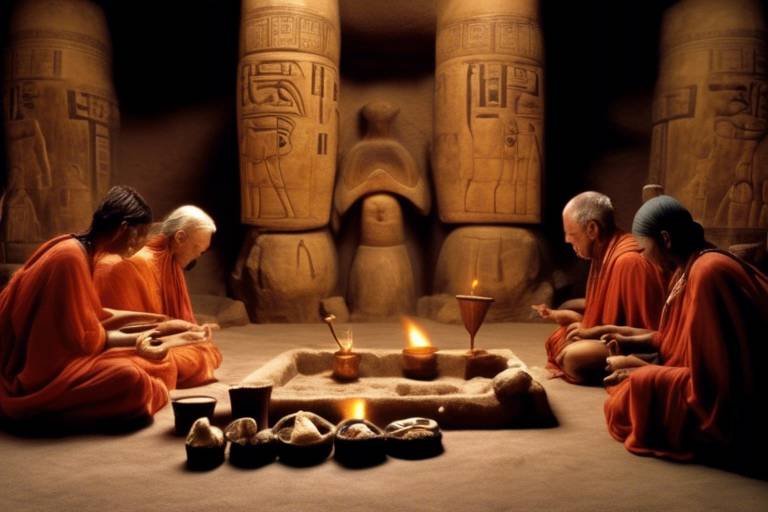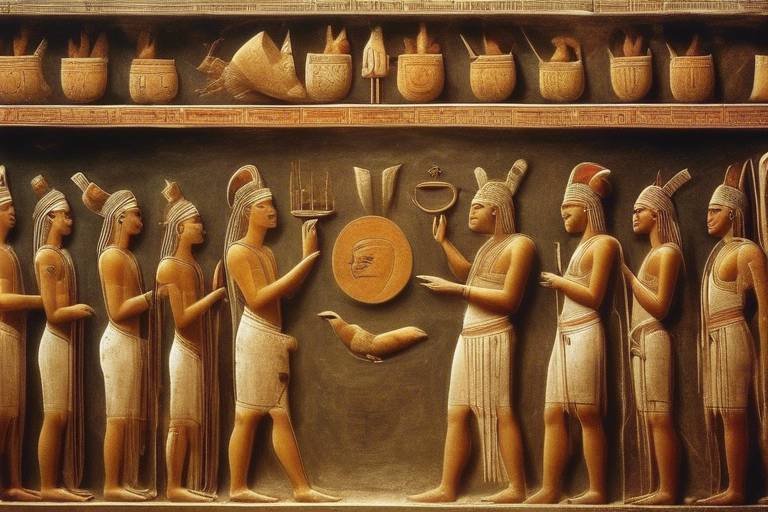The Impact of Globalization on Cultural Heritage
Globalization has brought about significant changes in the realm of cultural heritage, influencing the way traditions are preserved, transmitted, and evolved across the world. As societies become increasingly interconnected, the impact on cultural diversity and identity is profound, presenting both challenges and opportunities for communities striving to maintain their unique heritage.

Cultural Homogenization
Globalization has brought about a significant impact on cultural heritage, leading to both challenges and opportunities for communities worldwide. One of the key phenomena resulting from globalization is cultural homogenization, where diverse cultural practices and traditions are overshadowed by dominant global trends. This process often leads to the loss of unique elements of cultural heritage, as communities strive to align with mainstream practices and norms to stay relevant in the global arena.
Cultural homogenization can be likened to a powerful wave that sweeps across different cultures, eroding distinct traditions and identities in its path. As societies become more interconnected through trade, media, and technology, there is a tendency for cultural diversity to give way to a more uniform global culture, where traditional practices and beliefs are diluted or abandoned in favor of more commercially viable or popular alternatives.
Communities facing the challenges of cultural homogenization often find themselves at a crossroads, torn between preserving their unique heritage and adapting to the demands of a globalized world. The pressure to conform to dominant cultural norms can sometimes overshadow the importance of safeguarding traditional practices and values that have been passed down through generations.
While cultural homogenization poses a threat to the preservation of diverse cultural heritage, it also opens up opportunities for dialogue and exchange between different cultures. By recognizing the impact of globalization on cultural homogenization, communities can actively engage in discussions about the importance of preserving their unique identities and traditions in the face of increasing global influences.

Cultural Exchange and Fusion
In the realm of cultural exchange and fusion, globalization acts as a powerful catalyst, bringing together diverse traditions, practices, and beliefs from around the world. It's like a grand cultural potluck where each community contributes a unique dish, creating a vibrant tapestry of shared experiences and expressions. Through this exchange, cultures not only borrow from one another but also blend elements to form new, hybrid identities that reflect the interconnected nature of our global society.
Imagine a bustling marketplace where ideas, art forms, and culinary delights from different corners of the world converge, sparking creativity and innovation. This exchange goes beyond mere imitation; it involves a deep appreciation and respect for the richness of each culture, leading to the emergence of fresh perspectives and novel ways of self-expression. It's a dynamic process where boundaries blur, and cultural boundaries become fluid, allowing for the birth of dynamic and inclusive cultural landscapes.
Moreover, cultural fusion encourages dialogue and understanding among diverse communities, fostering a sense of unity amidst differences. It's akin to a beautiful mosaic where each piece, though distinct, contributes to the overall masterpiece, creating a harmonious whole that celebrates diversity. This fusion not only enriches individual cultures but also paves the way for collaborative endeavors that transcend geographical and societal divides.
Through cultural exchange and fusion, globalization offers a platform for mutual learning and appreciation, where traditions are not lost but rather transformed and revitalized in a global context. It's a celebration of the human spirit's boundless creativity and adaptability, showcasing the resilience of cultural heritage in the face of rapid change and interconnectedness.

Technological Advancements
Technological advancements play a crucial role in the preservation and promotion of cultural heritage in the era of globalization. With the rise of digital technologies, cultural institutions and communities have new tools at their disposal to safeguard and share their traditions with a global audience. Digital archiving, for example, allows for the digitization and preservation of artifacts, documents, and artworks, ensuring their longevity and accessibility for future generations.
Virtual museums represent another innovative application of technology in the cultural sector. These online platforms offer immersive experiences that transcend physical boundaries, enabling people from around the world to explore cultural heritage sites and exhibits virtually. Through virtual tours and interactive displays, users can engage with different aspects of a culture's history and traditions in a dynamic and educational way.
Online platforms dedicated to sharing traditional knowledge and practices also contribute to the preservation of cultural heritage. Communities can use websites, social media, and digital libraries to document and disseminate their cultural expressions, rituals, and languages, fostering intercultural dialogue and understanding. By leveraging technology, cultural practitioners can reach wider audiences and engage in cross-cultural exchanges that enrich and diversify global cultural landscapes.

Heritage Tourism
Heritage tourism, a product of globalization, has significantly impacted the way cultural heritage is perceived and experienced around the world. With the rise of international travel and the increasing interest in exploring diverse cultures, heritage sites have become popular destinations for tourists seeking authentic experiences. However, this trend brings both benefits and challenges to the preservation and promotion of cultural heritage.
On one hand, heritage tourism can provide economic opportunities for local communities by generating revenue from visitor attractions, supporting local businesses, and creating jobs in the tourism sector. It can also raise awareness about the importance of cultural heritage preservation and contribute to the maintenance of historical sites and traditions. Tourists engaging with local customs and practices can foster cross-cultural understanding and appreciation.
Conversely, the commercialization of cultural heritage sites for tourism purposes can lead to the commodification of traditions, potentially diluting their authenticity and significance. The influx of tourists may put pressure on delicate heritage sites, causing wear and tear or leading to overcrowding that disrupts the local community's way of life. Balancing the preservation of cultural integrity with the demands of tourism development is a complex challenge faced by many heritage destinations.
Moreover, the portrayal of cultural heritage through a tourist-centric lens may oversimplify complex historical narratives or perpetuate stereotypes, distorting the true essence of a community's heritage. There is a risk of cultural appropriation or misrepresentation when heritage sites are packaged as mere attractions for consumption, rather than being respected as living embodiments of a community's identity and values.
Ultimately, the sustainable management of heritage tourism requires a delicate balance between promoting cultural exchange and economic growth while respecting the authenticity and integrity of cultural heritage. By engaging in responsible tourism practices, preserving the unique identity of heritage sites, and involving local communities in decision-making processes, heritage tourism can become a force for positive impact, fostering mutual respect and appreciation for diverse cultural expressions.

Language and Identity
Language plays a crucial role in shaping individual and collective identities, serving as a vehicle for cultural expression and communication. In the era of globalization, the dominance of a few major languages can significantly impact linguistic diversity and identity worldwide. As global communication becomes increasingly standardized, indigenous languages face the risk of marginalization and extinction, posing a threat to the rich tapestry of linguistic heritage that defines various communities.
Furthermore, language is deeply intertwined with cultural practices, beliefs, and traditions, reflecting the unique history and worldview of different societies. The spread of dominant languages through globalization can lead to the erosion of indigenous languages, diminishing the cultural identity and sense of belonging for many communities. As languages fade into obscurity, valuable knowledge, stories, and cultural nuances are at risk of being lost, depriving future generations of their cultural heritage.
Efforts to preserve linguistic diversity and promote multilingualism are essential in safeguarding cultural identities in a globalized world. Language revitalization initiatives, education programs, and community-based language preservation projects play a vital role in maintaining the vitality of endangered languages and empowering communities to reclaim their linguistic heritage. By celebrating linguistic diversity and embracing multilingualism, societies can foster a more inclusive and culturally rich environment that honors the unique identities of all language speakers.

Global Policies and Cultural Protection
Globalization has brought about significant changes in the way cultural heritage is perceived and protected worldwide. As different cultures interact on a global scale, the need for policies and measures to safeguard cultural diversity and heritage has become increasingly crucial. International organizations, treaties, and policies play a vital role in ensuring that cultural heritage is protected from the negative impacts of globalization, such as cultural homogenization and commodification.
These global policies aim to promote cultural diversity and sustainable development by recognizing the importance of preserving unique traditions, languages, and practices. By setting standards and guidelines for the protection of cultural heritage, these policies help communities maintain their identities and heritage in the face of globalization's challenges.
One of the key aspects of global cultural protection policies is the emphasis on community engagement and empowerment. By involving local communities in decision-making processes regarding their cultural heritage, these policies ensure that the preservation efforts are sustainable and reflective of the community's values and needs.
Moreover, global policies often address the issue of cultural appropriation and misuse of cultural heritage for commercial purposes. By establishing frameworks for the ethical use of cultural resources and knowledge, these policies seek to prevent the exploitation of communities' heritage for profit at the expense of authenticity and integrity.
Through international cooperation and collaboration, countries can work together to protect and promote cultural heritage in a globalized world. By sharing best practices, resources, and expertise, nations can learn from each other's experiences and strengthen their efforts to safeguard cultural diversity and heritage for future generations.

Resistance and Revival
Resistance and revival are essential components in the narrative of cultural heritage preservation amidst the wave of globalization. In the face of homogenization and cultural dilution, many communities around the world are actively resisting the erasure of their traditions and identities. This resistance takes various forms, from grassroots movements to institutional initiatives, all aimed at safeguarding the unique cultural practices that define a community's heritage.
One powerful form of resistance is through cultural revitalization projects, where communities strive to revive traditional practices that have been on the brink of extinction. By reintroducing ancient customs, rituals, and art forms, these communities not only preserve their heritage but also instill a sense of pride and belonging among their members. It's a way of reclaiming their narrative and asserting their cultural distinctiveness in a globalized world.
Moreover, technological advancements play a significant role in enabling cultural revival efforts. Digital platforms and social media have become powerful tools for sharing and promoting traditional knowledge and practices. Through online networks, marginalized communities can connect with like-minded individuals globally, forming a supportive ecosystem for cultural preservation and revival.
Resistance to cultural homogenization also extends to the realm of language preservation. Many indigenous communities are fighting to revive endangered languages, recognizing the intrinsic link between language and cultural identity. Language revitalization programs, language immersion schools, and community language initiatives are examples of how communities are pushing back against the linguistic hegemony imposed by globalization.
Revival efforts are not just about preserving the past but also about adapting traditions to contemporary contexts. Communities are finding innovative ways to reinterpret their cultural heritage, blending old practices with modern influences to create dynamic and evolving cultural expressions. This fusion of tradition and innovation not only ensures the survival of heritage but also opens up new avenues for cultural exchange and dialogue.
In essence, resistance and revival are acts of resilience against the forces of globalization that threaten to homogenize and commodify cultural diversity. By embracing their heritage, communities assert their agency in shaping their own narrative and contribute to the rich tapestry of global cultural diversity.

Future Challenges and Opportunities
As we navigate the complex landscape of globalization and its impact on cultural heritage, it is crucial to anticipate the future challenges and opportunities that lie ahead. One of the key challenges facing communities worldwide is the threat of cultural homogenization, where unique traditions and practices risk being overshadowed by dominant global trends. This challenge calls for innovative strategies to preserve and promote cultural diversity in the face of increasing homogenization pressures.
Furthermore, the rapid advancement of technology presents both challenges and opportunities for the preservation and transmission of cultural heritage. While digital platforms offer new ways to archive and share traditional knowledge, there is also a risk of cultural commodification and misrepresentation in the digital realm. Navigating this digital landscape requires a careful balance between accessibility and authenticity.
Language diversity and identity also face significant challenges in a globalized world, as dominant languages continue to spread at the expense of indigenous languages. Preserving linguistic heritage is essential for maintaining cultural identities, yet it requires concerted efforts to ensure the survival of minority languages in the face of globalization.
On the flip side, globalization also presents opportunities for cultural exchange and collaboration on a global scale. By embracing cultural fusion and dialogue, communities can create new forms of expression that blend diverse traditions and perspectives. This cross-cultural pollination can lead to the emergence of innovative art forms, music genres, and culinary delights that enrich the global cultural tapestry.
Looking ahead, it is essential for communities to actively engage in the preservation and revitalization of their cultural heritage. Through grassroots initiatives, educational programs, and sustainable practices, communities can safeguard their traditions for future generations. By fostering a sense of pride and ownership over their cultural heritage, communities can resist the homogenizing forces of globalization and ensure the continued vibrancy of their unique identities.
Frequently Asked Questions
- What is cultural homogenization?
Cultural homogenization refers to the process where diverse cultural practices and traditions are overshadowed by dominant global trends, resulting in the loss of unique heritage elements.
- How does globalization impact heritage tourism?
Globalization has a significant impact on heritage tourism by commodifying cultural sites and practices for tourist consumption, which can both benefit and pose threats to the authenticity and integrity of cultural heritage.
- What role does technology play in preserving cultural heritage?
Technology plays a crucial role in preserving cultural heritage in the globalized world through digital archiving, virtual museums, and online platforms that facilitate the sharing of traditional knowledge and practices.
- Why is language diversity important in the context of globalization?
Language diversity is essential as globalization often leads to the spread of dominant languages, marginalizing indigenous languages and eroding linguistic heritage, highlighting the need to protect and promote linguistic diversity.
- How can communities resist the negative effects of globalization on cultural heritage?
Communities can resist the negative effects of globalization on cultural heritage by actively working to preserve and revitalize their traditions, reclaiming their identities, and engaging in sustainable practices for cultural preservation.



















